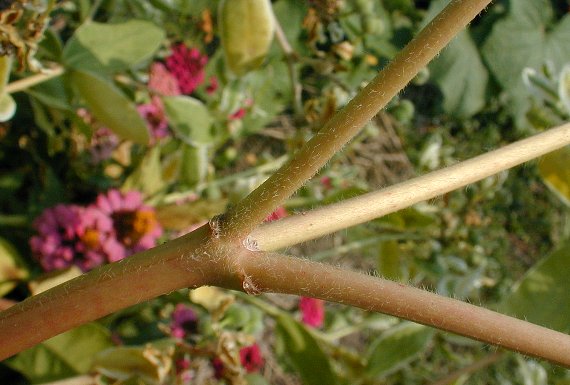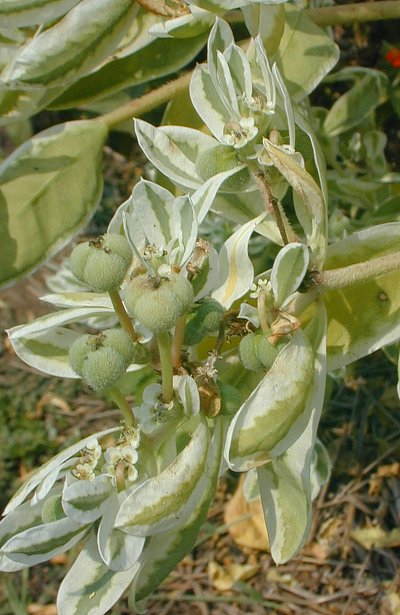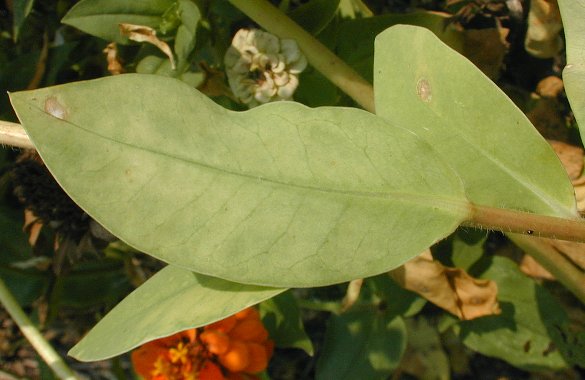Description: This plant is a summer annual that becomes 1-3' tall, branching frequently and often having a bushy appearance at maturity. The terete stems are initially light green to nearly white, but they later become light yellowish brown to reddish brown. Young stems usually have abundant white hairs, while older stems become more glabrous with age. The alternate leaves are 1½–3½" long and ½–1" across; they are oblanceolate, elliptic, or oblong-ovate in shape, smooth (entire) along their margins, and sessile to short-petiolate. The upper and lower leaf surfaces are either light green throughout or light green with white margins of varying width; they tend to be more variegated and white toward the tips of the stems where the flowers occur. Both leaf surfaces are also glabrous. In additional to the leaves, there are also opposite or whorled leafy bracts underneath the flowers near the tips of stems where the flowers occur; these bracts are somewhat smaller in size than the leaves, otherwise they have similar characteristics. As a plant matures, there is a tendency for the lower leaves to turn yellow and fall off the stems, particularly during dry weather.

The upper stems terminate in small clusters of narrowly cup-shaped cyathia containing both male and female flowers. These floral structures are typical of many species in the Spurge family, although their size is larger than average. The cyathia are about 4-6 mm. long and light green. Each cyathium has 4 glandular appendages along its upper rim; the glandular pit of each appendage is about 0.5 mm. long, green, reniform in shape, and concave above. Each glandular pit is surrounded by a winged extension of the appendage that is white, petal-like, and reniform-orbicular in shape. The male flowers within each cyathium are without sepals or petals; they consist of stamens with pale yellow anthers that are exserted slightly above the cyathium. The female flowers are also without sepals or petals; the female flower within each cyathium consists of a 3-celled pistil with 3 styles. The blooming period occurs from mid-summer into the autumn, lasting about 2-3 months. There is no noticeable floral scent.

Afterwards,
the female flowers become transformed into seed capsules that are 6-8
mm. across at maturity, subgloboid in shape, and 3-valved. These seed
capsules are strongly exserted from their cyathia by stout pedicels up
to 10 mm. long that are erect or nodding; these pedicels are glabrous
to pubescent.
The exterior of seed capsules is densely white-hairy. Each valve (or
cell) of each capsule contains a single seed. The seeds are 3-4 mm.
long, ovoid in shape, and minutely tuberculate. Eventually, the valves
of these seed capsules split open and fling their seeds up to several
feet by mechanical ejection. The root system
consists of a short branching taproot. This plant spreads by reseeding
itself.
Cultivation:
The preference is full sun, mesic to dry conditions, and any
well-drained soil. Most growth and development occurs during the
summer. This plant has good tolerance to drought.

Range &
Habitat:
Snow-on-the-Mountain has naturalized occasionally in scattered counties
across Illinois, particularly in the NE and west-central regions of the
state (see Distribution
Map). This plant is native to the Great Plains.
Because of its ornamental foliage, it is occasionally cultivated in
gardens, from where it sometimes escapes. Habitats include upland
prairies, hill prairies, areas along railroads and roadsides, pastures
and fallow fields, dumps and landfills, and waste areas. The seeds of
this plant can survive earth-moving operations and germinate wherever
the soil is dumped. In the Great Plains, this species is sometimes
regarded as a pest because it has a tendency to spread in pastures. In
Illinois, Snow-on-the-Mountain appears to be less aggressive and
persistent, more often occurring in waste ground and other highly
disturbed areas.
Faunal Associations:
The nectar and pollen of the flowers attract small bees, flies, and
probably wasps. Insects that feed on the foliage and other parts of
Snow-on-the-Mountain include Hippiscus
ocelote (Wrinkled Grasshopper), Melanoplus bivittatus
(Two-striped Grasshopper), Melanoplus
confusus (Little Pasture Grasshopper), Macrosiphum euphorbiae
(Potato Aphid), and the flea beetle Glyptina texana
(see Campbell et al., 1974; Thomas, 1877; Clark et al., 2004). Because
the foliage contains a toxic and irritating white sap, it is usually
avoided by mammalian herbivores. The seeds of this plant are sometimes
eaten by the Mourning Dove and probably other birds. While there is
additional information about floral-faunal relationships for this
species, it is more applicable to the Great Plains and Western states,
rather than the Midwest.

Photographic
Location:
A garden at Meadowbrook Park in Urbana, Illinois.
Comments:
Because of its white-margined leaves, Snow-on-the-Mountain has a
distinctive and attractive appearance, making it difficult to confuse
with any other plant species in Illinois. It is not the only species in
the Euphorbia family that has colorful foliage, however. For example,
the uppermost leaves and bracts of Euphorbia
cyanthophora
(Wild Poinsettia) are usually colored an attractive bright red. This
species also has a tendency to branch abundantly, presenting a bushy
appearance at maturity. Unlike Snow-on-the-Mountain, the leaves of Wild
Poinsettia are often pinnately lobed.